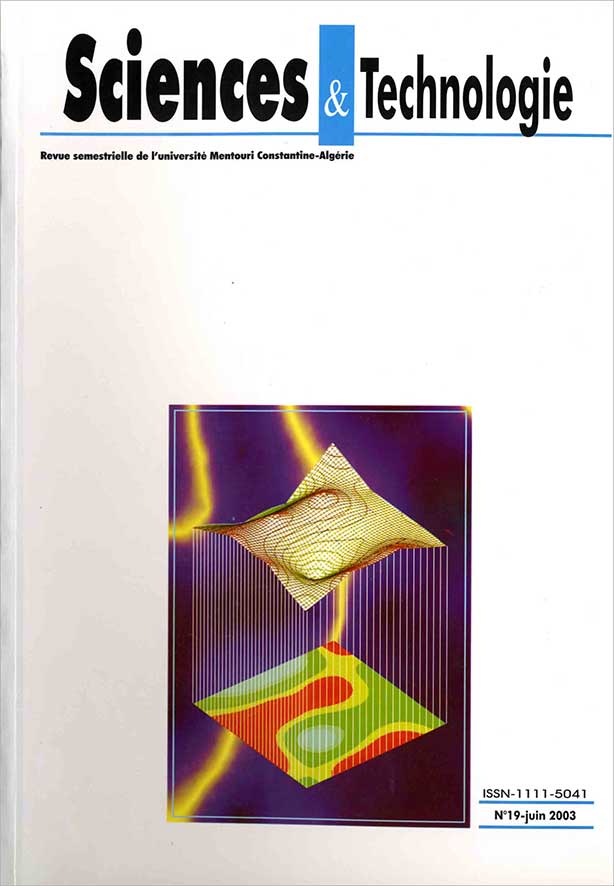ETUDE DES PRODUITS DE L’INTERACTION DE DEUX DISTRIBUTIONS DISTINCTES DE PARTICULES RADIOLYTIQUES CREEES LORS DE LA RADIOLYSE DE L’EAU PAR DES ELECTRONS
Keywords:
Diffusions, réactions, concentrations, rendements, radicaux, ADNAbstract
En vue d’améliorer les performances du modèle déterministe quant à l’étude des interactions des électrons avec l’eau liquide, nous avons élaboré des codes numériques basés sur la résolution de l’équation de diffusion qui nous permettent de suivre l’évolution spatio-temporelle jusqu’à la jonction, de deux distributions distinctes d’espèces radiolytiques, créées 10-12 s après la radiolyse de l’eau par des électrons d’énergies comprises entre 200 et 1000 eV. Les concentrations, ainsi que les rendements radiolytiques de ces espèces (, H, OH, , H2, H2O2, , O2, , HO2, ) ont été estimés aussi bien dans l’espace englobant les deux distributions que dans la région comprise entre ces mêmes distributions. Nos résultats ont ensuite été comparés avec ceux obtenus par les méthodes semi-implicite et stochastique.
Downloads
References
- Saifi A., "Application de l’approche déterministe à l’étude sur ordinateur des processus radiolytiques induits dans l’eau par des électrons", Thèse de doctorat d’université, N° 915, Toulouse, (1991).
- Terrissol M., Beaudre A., "Simulation of space and time evolution of radiolytic species induced by electrons in water", Radiat. Prot. Dosim., 31, (1990), pp. 171-175.
- Wolff R.K. , Bronskill M.J., Aldrich J.E., Hunt J.W., "Picosecond pulse radiolysis. IV. Yields of the solvated electron at 30 ps", J. Phys. Chem., 77 (11), (1973), pp. 1350-1355.
- Turner J.E., Hamm R.N., Wright H.A., Ritchie R.M., Magee J.L., Chaterjee A., Bolch W.E., "Studies to link the basic radiation physics and chemistry of liquid water", Rad. Res. Chem., 32 (3), (1988), pp. 503-510.
- Shwarz H.A., "Applications of radiation chemistry. II. Effects trac in radiolysis of water", J. Phys. Chem., 73, N°6, (1969), pp. 1928-1937.
- Mozumder A., Magee J.L., "Selected specific rates of reactions of transients from water in aqueous solutions. Hydroxyl radical and perhydroxyl radical and their radical ion", Report NSRDS-NBS 59, Dept. of commerce / National bureau of standards, Washington, DC, (1977).
- Magee J.L., Chaterjee A., "A spur unfolding model for the radiolysis of water", Rad. Phys. Chem., 15, (1980), pp. 125-132.
- Neff H., Sass J.K., Leweren H.J., Ibach H., "Photoemission studies of electron localization at very low excess energies", J. Phys. Chem., 84, (1980), pp. 1135-1139.
- Konovalov V.V, Raitsimring A.M., Tsvetkov Y.D., "The thermalization length of low energy electrons determined by nanosecond photoemission into aqueous electrolyte solutions", Chem. Phys., 93, (1985), pp. 163-170.
- Czapski G., Peled. E., "On the scavenging of eaq and on the possible breakdown of Smoluchowski’s equation at high concentrations of solutes", J. Chem. Phys., 77, 7, (1973), pp. 893-897.
- Demonchy M., "Modélisation de l’effet primaire des rayonnements sur l’A.D.N. dans son environnement", Thèse de doctorat d’université, N° 2680, Toulouse, '1997).
- Burns W.G., May R., Baverstock K.F., "Oxygen as a product of water radiolysis in high LET tracks. I. The origin of the hydroperoxyl radical in water radiolysis", Radiat. Res., 86, (1981), pp. 1-19.
- Hill M.A., Smith F.A., "Calculation of initial and primary yields in the radiolysis of water", Radiat. Phys. Chem., 43 (3), (1994), pp. 265-280.
- Zaider M., Brenner D.J., "On the stochastic treatment of fast chemical reactions", Rad. Res., 100, (1984), pp. 245-256.
- Boyd A.W., Carver M.B, Dixon R.S., "Computer and experimental product concentrations in the radiolysis water", Radiat. Phys. Chem., 15, (1980), pp. 177-185.
- Buxton G.V., Greenstock C.L., Helman W.P., Ross A.B., "Critical review of rate constants for reactions of hydrated electrons, hydrogen atoms and hydroxyl radical in aqueous solution", J. Phys. Chem., 17 (2), (1988), pp. 513-886.
- Ferradini C., Puchault J., " Biologie de l’action des rayonnements ionisants", Paris : Ed. Masson, (1983).
- Zienkiewicz O.C., "La méthode des éléments finis", Paris, MC Graw-Hill, (1971).
- Chatwiti A., "Etude de l’évolution temporelle des électrons dans un gaz faiblement ionisé", Thèse de doctorat d’état, N° 1381, Toulouse, (1988).
- Patankar S.V., "Numerical heat transfer and fluid flow", Paris, Mc Graw-Hill, (1983).
- Saifi A., "Résolution de l’équation de diffusion par une méthode semi-implicite. Application au cas de la radiolyse de l’eau par des électrons", Radioprotection, 30 (4), (1995), pp. 557-573.
- Boumahrat M., Gourdin A., "Méthodes numériques appliquée", Alger, OPU, (1983).
- Jonah C.D., Hart E.J., Matheson M.S., "Yield and decay of the hydrated electron at times greater than 200 ps", J. Phys. Chem., 77 (15), (1973), pp. 1838-1843.
- Sumiyoshi T., Katayama M., "The yield of hydrated electron at 30 ps", Chem. Lett., (1982), pp. 1887-1890.
- Brenner D.J., Zaider M., "Calculation of the decay radiation induced free radical in the presence of scavengers using stochastic techniques", Radiat. Res., 1, proceedings of the 9th int. congress of radiat. Res., Edinburg, Abstract A51-6P, (July 1987), p. 48.







